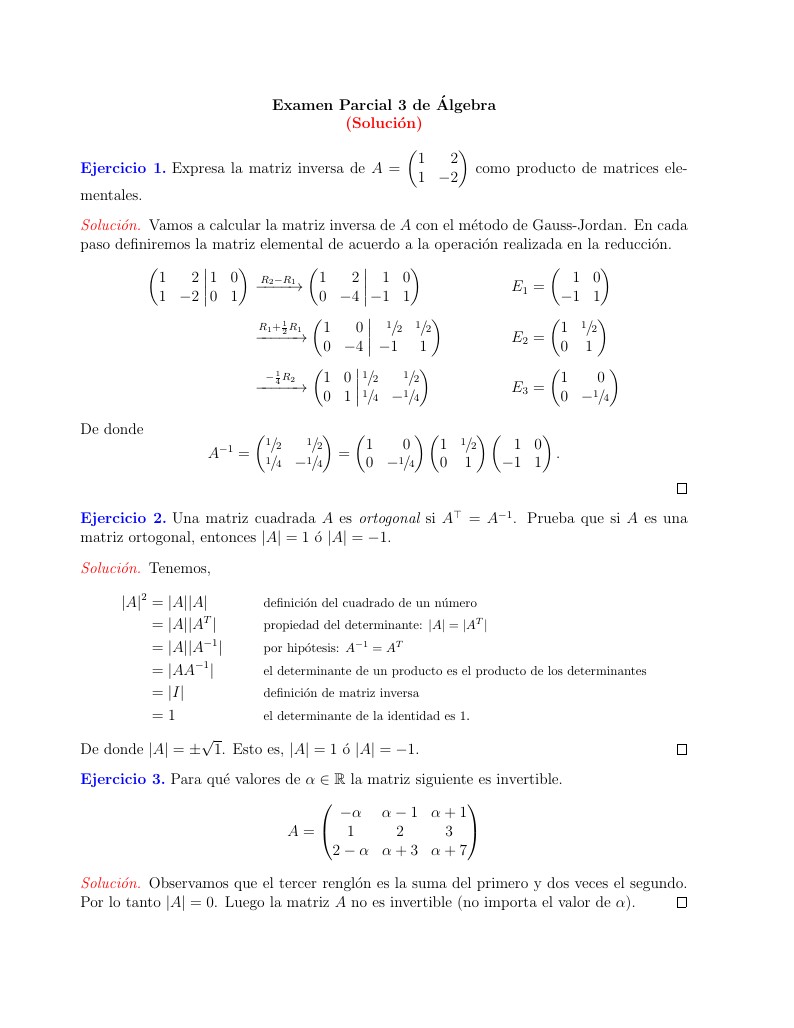
Solucion parcial 3
Author:
Memo Garro
Last Updated:
8年前
License:
Creative Commons CC BY 4.0
Abstract:
Solución al tercer examen parcial del curso de Algebra

\begin
Discover why over 20 million people worldwide trust Overleaf with their work.
Solución al tercer examen parcial del curso de Algebra

\begin
Discover why over 20 million people worldwide trust Overleaf with their work.
\documentclass[12pt,oneside,geqno]{article}
\addtolength{\textheight}{120pt}
\oddsidemargin=-10pt
\topmargin=-.5in
\textwidth=6.5in
\pagestyle{empty}
\usepackage{amssymb,latexsym,amsmath,amsthm}
\usepackage{amsfonts,rawfonts}
\usepackage{thmtools}
\usepackage{systeme}
\usepackage{mathtools}
\usepackage[usenames,dvipsnames]{color}
\usepackage{xcolor}
\usepackage{xfrac}
\declaretheoremstyle[
headfont=\color{blue}\normalfont\bfseries,
notefont=\bfseries,
notebraces={}{},
%bodyfont=\color{red}\normalfont\itshape,
bodyfont=\normalfont,%\itshape,
%headformat=\NUMBER.~\NAME\NOTE
headformat=\NAME\NOTE
]{colorejercicio}
\declaretheorem[
%numbered=no,
style=colorejercicio,
name=Ejercicio
]{ejercicio}
\begin{document}
\begin{center}
{\bf Examen Parcial 3 de \'Algebra}
{\bf \color{red}{(Soluci\'on)}}
\end{center}
\begin{ejercicio}[1]
Expresa la matriz inversa de $A=\begin{pmatrix} 1 & \phantom{-}2\\ 1 & -2\end{pmatrix}$ como producto de matrices elementales.
\end{ejercicio}
\begin{proof}[\color{red}{Soluci\'on}]
Vamos a calcular la matriz inversa de $A$ con el m\'etodo de Gauss-Jordan. En cada paso definiremos la matriz elemental de acuerdo a la operaci\'on realizada en la reducci\'on.
\begin{align*}
\left(
\begin{matrix}
1 & \phantom{-}2\\
1 & -2
\end{matrix}
\right.\left|\left.
\begin{matrix}
1 & 0\\
0 & 1
\end{matrix}
\right)\right.&\xrightarrow{\, R_2-R_1\, }\left(
\begin{matrix}
1 & \phantom{-}2\\
0 & -4
\end{matrix}
\right.\left|\left.
\begin{matrix}
\phantom{-}1 & 0\\
-1 & 1
\end{matrix}
\right)\right. &E_1&=\begin{pmatrix} \phantom{-}1 & 0\\-1 & 1\end{pmatrix}\\[0.5em]
&\xrightarrow{R_1+\frac12R_1}\left(
\begin{matrix}
1 & \phantom{-}0\\
0 & -4
\end{matrix}
\right.\left|\left.
\begin{matrix}
\phantom{-}\sfrac12 & \sfrac12\\
-1 & 1
\end{matrix}
\right)\right. &E_2&=\begin{pmatrix} 1 & \sfrac12\\0 & 1\end{pmatrix}\\[0.5em]
&\xrightarrow{\, \ -\frac14R_2\ \, }\left(
\begin{matrix}
1 & 0\\
0 & 1
\end{matrix}
\right.\left|\left.
\begin{matrix}
\sfrac12 & \phantom{-}\sfrac12\\
\sfrac14 & -\sfrac14
\end{matrix}
\right)\right. &E_3&=\begin{pmatrix} 1 & \phantom{-}0\\0 & -\sfrac14\end{pmatrix}
\end{align*}
De donde
\[
A^{-1}=
\begin{pmatrix}
\sfrac12 & \phantom{-}\sfrac12\\
\sfrac14 & -\sfrac14
\end{pmatrix}=\begin{pmatrix} 1 & \phantom{-}0\\0 & -\sfrac14\end{pmatrix}\begin{pmatrix} 1 & \sfrac12\\0 & 1\end{pmatrix}\begin{pmatrix} \phantom{-}1 & 0\\-1 & 1\end{pmatrix}.
\]
\end{proof}
\begin{ejercicio}[2]
Una matriz cuadrada $A$ es {\em ortogonal} si $A^\top=A^{-1}$. Prueba que si $A$ es una matriz ortogonal, entonces $|A|=1$ \'o $|A|=-1$.
\end{ejercicio}
\begin{proof}[\color{red}{Soluci\'on}]
Tenemos,
\begin{align*}
|A|^2&=|A||A| && \text{\footnotesize definici\'on del cuadrado de un n\'umero}\\
&=|A||A^T| && \text{\footnotesize propiedad del determinante: $|A|=|A^T|$}\\
&=|A||A^{-1}| && \text{\footnotesize por hip\'otesis: $A^{-1}=A^T$}\\
&=|AA^{-1}| && \text{\footnotesize el determinante de un producto es el producto de los determinantes}\\
&=|I| && \text{\footnotesize definici\'on de matriz inversa}\\
&=1 && \text{\footnotesize el determinante de la identidad es $1$}.
\end{align*}
De donde $|A|=\pm\sqrt1$. Esto es, $|A|=1$ \'o $|A|=-1$.
\end{proof}
\begin{ejercicio}[3]
Para qu\'e valores de $\alpha\in\mathbb{R}$ la matriz siguiente es in\-ver\-ti\-ble.
\[
A=
\begin{pmatrix}
-\alpha & \alpha-1 & \alpha+1\\
1 & 2 & 3\\
2-\alpha & \alpha+3 & \alpha+7
\end{pmatrix}
\]
\end{ejercicio}
\begin{proof}[\color{red}{Soluci\'on}]
Observamos que el tercer rengl\'on es la suma del primero y dos veces el segundo. Por lo tanto $|A|=0$. Luego la matriz $A$ no es invertible (no importa el valor de $\alpha$).
\end{proof}
\end{document}